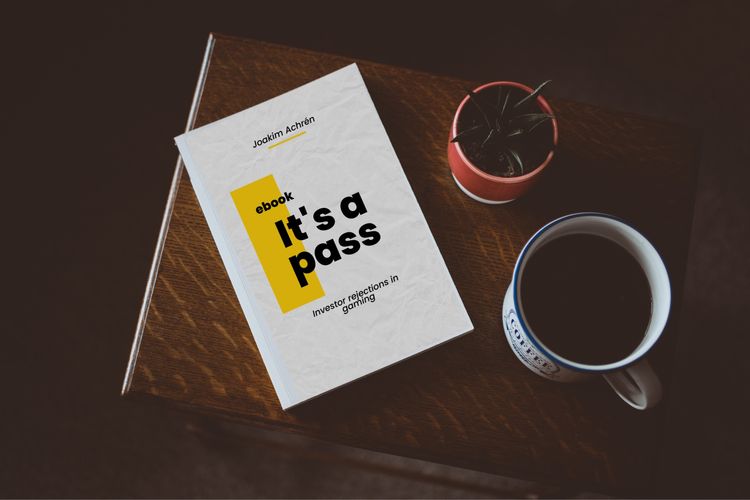EGD News #109 — Success in fundraising

Sent on November 19th, 2021.
If you aren’t a subscriber to EGD News, you can subscribe here.
💰 Success in fundraising
I’ve never succeeded in a fundraise without a proper plan and process. Why do you need a plan and a process?
A. Execute the raise in half the time.
B. You can get multiple competing term sheets.
C. You’re not leaving anything to chance.
If you are selling something that no investor is willing to buy, the process will help you get to that realization much quicker than an unstructured investor outreach.
Think about it: you can reach out to three investors from your list of investors, go through the process with them and figure out where you stand.
Let’s talk about the phases of successful fundraising, which are: preparation (the materials), fundraising (meetings), and closing (DD and legal).
Preparation
These are the materials that you’ll want to be working on. Note that as you start having meetings with investors, you’ll want to read what feedback you are getting and then evaluate if this feedback should somehow be taken into account with your material.
It’s preferred not to have actual pitch meetings with investors before you’ve assembled all the material. But, in most cases, it is beneficial to have some unofficial founder-investor meetings, to get to know them and ask questions. You can ask where they invest, what their limited partners, who’ve put money into the VC fund, are looking for, and why they picked that particular VC fund to invest in.
All the questions that you can ask will help you immensely to prepare for a funding round. You can make sure that you are spending time highlighting the right things in your materials.
Here’s the material that you’ll need to work on.
1. Investor spreadsheet
Here’s the Investor spreadsheet template. You should take a look at it and use it for building your list of investors. The main reason to have a Spreadsheet like this is to create a strict process of conducting the fundraise. Since you want co-founders, advisors, and existing investors to collaborate on the fundraise, you can keep them updated on things and ask them to fill in details as they emerge.
The template contains two sheets.
The first one lists the investors you know of that you’ll want to reach out to. Try to list people, not funds, as you want to build a personal relationship with the manager that you’d be working with.
Many founders approach the fundraise by selecting funds to reach out to, but I’d always suggest reaching out to the people. It means a lot to the manager if you state that you’d want to work with them mainly.
This also helps when you are thinking about the priority order of the firms. Let’s say there’s a big brand name VC, who doesn’t specialize in gaming, but they have one partner that does make gaming investments. List that person on the Spreadsheet.
If the big brand name VC doesn’t do gaming and doesn’t have people making gaming investments, it would be a pass, and they wouldn’t end up on the list. Bottom-line is that you’d want people like these on your cap table.
So the first sheet is your list of investors, and the second one is for tracking progress once you start engaging with these investors.
You can insert the investor information into the first sheet called “Investors” and then copy a row’s first four columns to the “Engaged investors” once you start talking to that investor.
When you are still collecting information for the list, you can ask around from other founders or other people who are familiar with the partner for these details. If you are unsure which partners are a good fit for you, you can ask other founders for partners that could be a good fit.
If you don’t know other founders, then it’s time to start cold-messaging people on LinkedIn, asking, “Hey, I’m looking to raise money for my game studio. Can you name three investors (partners at funds) that I should consider?” Once you get them to send you a few names, ask for more details, specifically to fill in the columns in the Spreadsheet.
Let’s go through the columns for the “Investors” sheet, which you should be filling out first before reaching out. Try to get more than five people here. Ten would be preferable before you engage the investors.
Top pick – This is the priority that this investor will receive.
Investor name – You want a person, not a fund. The person will be the one who adds value after the money has arrived. Don’t raise just for the money. Raise to get a partner onboard into the business.
Affiliation — The fund that this partner works at.
Check size — The sizes of the investment that the fund typically invests in. It can be a big range, but it’s very good to know.
LinkedIn — LinkedIn page for the partner
Website of the fund — The fund’s website
Related Investments — Has the partner been involved in other gaming investments? List the ones that you know of.
Focus area — What kind of investments is the partner looking to do at the moment. If you are building a crypto gaming company, are they doing crypto gaming?
Active — Are they actively looking at gaming. This is important for partners who work as generalist investors and might not be placing bets into gaming. There might be several reasons, maybe the fund they invest from has made enough gaming investments, and they have a diversification strategy where they need to make other bets that are non-gaming, tech, etc.
Notes — Here, you’d want to write some notes that will relate to the partner. This is a great place to share information for collaborators on the fundraise, people who will also be using the Spreadsheet: co-founders and advisors, and the likes.
Connection — Who is going to intro you to the investor.
Connection Notes — Here, you can write a summary of how the initial connection to the partner went. Note! The discussion status details and things should be left to the “Engaged investors” sheet.
Once you have engaged with the investor, you can start filling out the rows for them in the “Engaged investors” sheet:
Top pick, Investor Name, Affiliation, and Check size can be copied from the previous sheet.
Process — Once you have the first discussion with the partner, ask how the partner can make an investment decision. It’s good to know because they might have a committee meeting or several meetings before they can make a decision. Or they might prefer other procedures to make decisions, which can take up lots of time. It’s beneficial for you to know how long it can take for them to come up with a decision.
Status — What has happened so far.
Next steps — What are the following steps to decide if the partner will invest or not.
Last touchpoint — What was the date when you last talked to the partner.
Who introduced you — Who did the intro to the investor.
Notes — Additional notes, concerns, or opportunities should be written here. Things that have come up in the discussions with the investor should be shared with your collaborators.
Now, let’s move to the other material you’d need to produce before engaging the investors.
2. Introduction blurbs
When you start reaching out to investors, it’s worthwhile to have some mutual connections to them to make introductions. Cold emails are OK, but nothing beats a warm introduction since it gives some credibility that the referrer has vetted you. You will be asking your ex-colleagues, other founders, or existing investors to send out a pre-written introduction blurb so that the referrer has the least amount of work to send out the introductions.
Example:
Hi [Investor first name], I’d like to introduce [your name], the founder of [insert your company name]. They are building a game studio that focuses on blockchain games for non-crypto fanatics. They have excellent plans on how to broaden the current market of PTE and NFT games. Based on your existing investments in the space, I think it would make sense to look at them as they are preparing a fundraise. All the best!
Here’s a related article on how to ask for intros, written by Elizabeth Yin from Hustle Fund.
3. Deck
I’ve written extensively on pitch decks. You should have a short pitch deck that you’d send in your first email to the partner. Then, have the extended pitch deck ready with more details on the company, which the partner might ask for at any point.
My pieces and articles on pitch decks:
How to Create a Game Studio Pitch Deck
Pitch “What we do? What’s our secret?”
Perfect Games Company Pitch Deck Breakdown
Pitch Your Games Company — The Online Course
4. Financials
Sharing financial estimates and projected costs shows that you are on top of things. A breakdown of your financials for the next 12 to 24 months will be an excellent piece to have ready when you start meeting with investors, as it can come up in meetings and email exchanges.
I’ve written previously about financial documents. Here are a few items to check out:
Game studio PnL template created by Ilya Eremeev from Games Fund
5. Investor FAQ
The meeting with the investors will never amount to a lot of all you will cover is the pitch deck. 95% of the meeting will be about asking questions, with both you and the investor doing the asking and answering.
Let’s first cover the frequently asked questions that an investor will ask. It would be helpful for your fundraising process to prepare an FAQ for the questions that the investor will ask.
I’ve previously written about these questions, but here are a few that might come up and how I, Joakim, would answer them if I were in the founder’s position.
Question: What makes you a more prepared team to make a successful company than what you could have accomplished five years earlier?
Answer: Five years earlier, I was doing my first startup, where we made lots of mistakes, but we did spend a lot of time reflecting on the mistakes. Now I feel that what has happened in the last five years, including that I also started to spend more time with more experienced CEOs in the industry, I’m much more prepared and skilled to build a successful company.
Question: Why is Dream Games doing so well with Royal Match? (Note! This question is valid in Q4 of 2021, replaced with a new company and new game when you feel that this question is not going to come up anymore 🙂
Answer: The team at Dream Games built a career in puzzle games at Peak Games, and they shipped some of the biggest top-grossing puzzle games of all time. Now, as they decided to do their own game studio, they are applying all the learnings from Peak, combined with state-of-the-art user acquisition.
6. Your FAQ to investors
You want to ask questions from the investors. Here are a few important ones.
Question: How do you make investment decisions? Can you personally decide on an investment?
Question: What is the check size and valuation range where you typically invest? Do you have a maximum or minimum?
Question: Can you comment on our cap table? Does it look all OK, or should we change something there?
Why does this question matter? Founders should never hide their cap tables since investors will want to take a look at them. And founders should know that cap tables can be modified, they are never carved in stone. If you could have a VC coming on board but you have ex-founders, ex-advisors, owning large chunks of the company, there can always be a negotiation where the cap table is recapitalized. It’s unfortunate when the cap table is shown to investors at the last moment, and the whole deal dies. Share the cap table as early as possible with investors.
Question: How do you usually help founders who you’ve invested in? Do you have biweekly meetings or other ongoing helping activities?
Why does this question matter? Never take investors just for the money, you want partners in the business.
Question: Will you have the possibility to invest in future rounds? Can you lead future rounds?
Why does this question matter? You want to be sure that the investor has the possibility to back you in the future. Some VCs might have a fund that has already allocated most of their funds and they can’t re-invest in their portfolio companies as much as they’d like. Make sure that you know what the future will look like if and when you need more investor money.
Conclusion
You are now ready for the fundraise! By preparing, you’ll have clarity on the process, which allows you to have a much better idea of the potential outcome.
One final tip:
At the end of the first meeting, always ask if the investor is interested. If they are, ask about their process and the next step. This is critical. Having clarity on the process is necessary to determine whether you are moving forward or not. For example, some firms have you meet with one partner, then with two partners, and then they decide in a final all-partners meeting. Some angels decide after two meetings with the founder, etc.
To finish up, all I want to say is good luck and if you have any further questions, read more items that I’ve posted on fundraising on my blog here at Elite Game Developers.
(Photo by Devon Janse van Rensburg on Unsplash)





